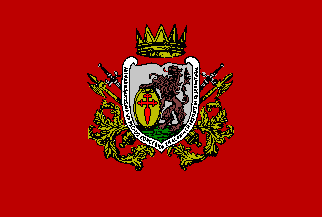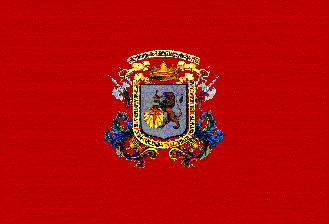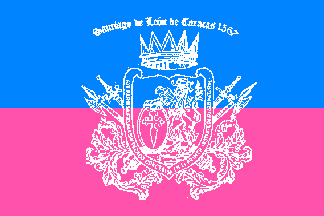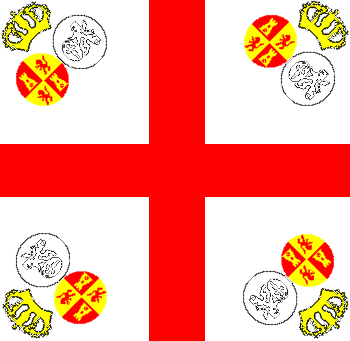
by Guillermo Aveledo, 4 October 1999

Last modified: 2014-05-22 by zoltán horváth
Keywords: caracas | venezuela | lion | santiago cross | regimant | amaranth |
Links: FOTW homepage |
search |
disclaimer and copyright |
write us |
mirrors

by Guillermo Aveledo, 4 October 1999

by Raul Jesus Orta Pardo, 2 August 2000
Libertador Municipality (Municipio Libertador), City of Caracas
Hustorical Flags:
See also:
Other Sites:
"Caracas" is the word used by the aboriginal tribes
which lived on the north coastal regions of the earlier
Venezuela, for named an autochthonous kind of a plant called
"Amaranth" in another places of the World. Besides,
this plant was one of their principal sources of nutrition. When
the Spanish conquerors arrive to these lands, they find the
tribes eating it. After their inquires by words and mimics about
the name of the plant, one of the aboriginal could understood the
questions of these rare men and standing up, saying
"CARACARA, CARACAS", and fluttering a bundle of that
herbs at the same time.
Sometimes, the Spanish conqueror's custom was to name the cities
and towns, which they founded during the earlier times of their
dominion over Latin America. However, they composed these names
with autochthonous voices in combination with Spanish holy
sponsors, places or authorities at that times.
According to that tradition, on July 25th, 1567, the Captain
Diego de Losada y Osorio founded the City of "SANTIAGO DE
LEON DE CARACAS" (Saint James of the Lion of Caracas), in
the same place where it exists today , the "Plaza
Boli'var" (Bolivar Square), then called "Plaza
Mayor" (Major Square). Later, the Spanish King Felipe II
(Philippe II) granted to the City their first Coat
of Arms by means of negotiations realized by Don Simo'n de
Bolivar, called "El Viejo" (The older), sixth ancestor
of "El Libertador" SIMON BOLIVAR, our greatest national
hero. These arms only show a brown lion rampant subjecting a
golden scallop with a red St. James Cross inside, all on an
argent (silver) ground. Few years after, it was enriching with a
five points coronet in the crest and war trophies crossed in
saltire at the back in attention to the notable services of their
subjects to the Spanish Crown. By royal schedule signed on March
15th, 1766, the king Carlos III (Charles III) granted to the
Caracas CoA's a pennant with a motto, which express the devotion
of the Caraquenian people for the Holy Mother of God: "AVE
MARIA SANTISIMA SIN PECADO CONCEBIDA EN EL PRIMER INSTANTE DE SU
SER NATURAL" (God Bless You Holiest Mary conceived without
guilt in the first instant of her natural being). Therefore, the
meaning of the Caraquenian CoA its really very simple because it
is "Canting Arms": the golden scallop is representation
of the Apostle Santiago (also called Saint James in English), one
of the holy sponsors of Spain and particularly, for the Spanish
Cavalry; the Lion reminds the Spanish kingdom and the Province of
Leo'n (Lion) where the Conqueror Losada y Osorio was born and
besides, it is an homage for Don Pedro Ponce de Leo'n, Spanish
Governor of the province of Venezuela at that times, who provides
the sources for the successful conquest of the region where was
established the actual Caracas. The argent (silver) ground
represents the Integrity. The golden five points coronet (called
"Coronel" in Spanish) is symbol of Nobility and
Loyalty. The Arms crosses in saltire represents the courage of
the Caraquenian People, whose example of behavior, ever has been
an obligatory reference for the another peoples of Venezuela and
Latin America. So, the full ancient form of the name of the
Capital City of my Country and my birth place too, is "LA
MUY NOBLE Y MUY LEAL SENORIA DE LA CIUDAD MARIANA DE SANTIAGO DE
LEON DE CARACAS" (The Most Noble and Most
Loyalty Seigniory of the Marian City of Saint James of
the Lion of Caracas). In this case,"Marian" has the
meaning of "Devote of the holiest Virgin Mary".
Raul Jesus Orta Pardo, 2 August 2000
The CAPITAL DISTRICT: According to the "Bolivarian
Constitution of Venezuela" (Article 16) recently approved,
it is implicatly abolished the "Federal District" by
the creation of the CAPITAL DISTRICT formed by the same
Municipalities which were in the FD. However, the real dimension
of the City exceed its original limits of the last 60 years and
now also contain the Municipalities of Baruta, Chacao, El Hatillo
and Sucre which belong to the Miranda State.
The "Bolivarian Constitution of Venezuela" establishes,
besides, that the regulations about the matter will be specifying
in a Special Law.
Raul Jesus Orta Pardo, 2 August 2000
The special law on the regime of the Capital District,
hindsighted on the 18th article of this
Constitution, wil be approved by tne National Constituent
Assembly and it will preserve the territorial integrity of the
MIranda State. Meanwhile the law is to be approved, the Organic
Law of the Federal District and the Organic Law of Municipal
Regime."
The National Constituent Assembly issued a Special Law on the
regime of the METROPOLITAN DISTRICT OF CARACAS, on March 8th,
2000. This would make the Constituent Assembly deaf to its own
voice, since:
1. The Constitution dictated that the Assembly would approve a
law for a CAPITAL DISTRICT of CRACAS, not a METROPOLITAN DISTRICT
of CARACAS, which it did.
2. According to the very 'Bolivarian' Constitution they wrote,
the members of the National Constituent Assembly should've known
we can only have a "Metropolitan District": "when
two or more municipalities belonging TO THE SAME FEDERAL ENTITY
have economic, social and phsical relations which would give to
their union the carachteristics of a metropolitan area
(...)".
What happens is that the Municipios Chacao, El Hatillo, Baruta
and Sucre belong to Miranda State, and the Municipio Libertador
(colloquially Caracas) belongs to the Capital District (which
lurks back again, without many explanations, in article 1 of the
special law ). Miranda State and the Federal district are two
separate, distinct, unique entities; this makes the name (and
even the entire law) of the Metropolitan District utterly wrong!!
But that doesn't seem as good enough to make it null and void ...
Although it may seem like a rumbustious "legalese"
complaint, I am sure it will hold many problems for the future,
especially when stating the actual responsabilities of each
municipal government and that of the Metropolitan mayor, and
these frictions will grow when the time comes for the National
Treasure to be distributed and no one caves in: when resources
are scarce, someone will pay attention to the small print, make a
lot of noise and simply refuse to acknowledge the legitimacy of
the resource distribution scheme .
This rises a few vexiollogical questions to the forefront:
1) Should the METROPOLITAN-CAPITAL (?) DISTRICT of Caracas use
the crimsom flag with the Caracas CoA?
I would say... NO!! This flag belongs, in any case, to the
Federal District, and, more specifically, to the Municipio
Libertador ("old" Caracas). It never flew on top of the
building of the Governorship of the Federal District (north of
Bolivar Sqare), which only bore the Venezuelan National flag. So,
the Municipio Libertador should keep using the crimsom flag as
its own, as it covers the territory of the original Caracas (plus
a few more sq. miles), as it was in 1567. The Alcaldia of the
Municipio Libertador has its own flag
(magenta-blue) and I assume each Municipio has a flag of its
own. In any case, they should, and the "rebranding" of
the city could start that way.
2) Then, is it feasible and historically accurate to give the
'MC?' District of Caracas a flag of its own?
I would think so. A most definite YES for that. As a contemporary
Caraquenian, I believe it should reflect both tradition and
modernity, and the fact that it encompasses not one but five
cities.
Guillermo Aveledo, 11 August 2000
A burgundy field. With the Caracas CoA as badge.
Burgundy has been the City's colour as long as anyone can
remember, but no particular meaning is attached to them. Probably
it was a variation of the colour of the Santiago Cross, emblem of
the city. Incidentally, Venezuela's national football team wears
burgundy on their uniform.
based on the designs showed on the 1981 edition of "Los
Simbolos Sagrados de la Nacion Venezolana", by Francisco A.
Vargas. This is a study on the development of the
Venezuelan Flag, CoA and Anthem, plus a study on the States' CoA
Guillermo Aveledo, 4 October 1999
This flag is for Caracas City but not for the Distrito Federal
, that is not exactly the same. Flag of DF is also red but with
DF arms in center (instead the Caracas ones). In "Vlajka
statu a uzemi Sveta" the arms are correct but the background
color (white) is wrong because in fact it is red. DF adopted flag
in c. 1980 and the adoption was made officially (according info
from their representatives in 1989).
Caracas city has similar flag, but seems that a variant is
frequently in use (including in official acts): red with white
oval with arms. The white oval was tailed from white rectangular
clothes manufactured by Bendayan & Cia of Caracas (they make
white flag with all the states arms, but not for use mainly as
flags but for showing the arms) and attached to a plain
rectangular red flag.
Jaume Ollé, 3 November 1999
It is the Flag of the Municipality of Caracas, and it is the
one flying from the Alcaldía and the Cabildo buildings. So I
assume it is official. Yet there is no such thing as an official
ruling on this matter by the Concejo Municipal . The DF
Government which governs a portion of territory now identical to
that of the Municipality of Caracas (actually, Municipio
Libertador), has no flag flying from its offices nor inside its
buildings. They use the Venezuelan State Flag, being a branch of
the Central Executive and an office appointed by the President
himself. The background for the Municipality flag is NOT red, but
burgundy, vino tinto, grana, and has not any white oval. However,
the flag hoisted on the Municipality buildings is quite old and
deteriorated and I could be wrong.
Guillermo Aveledo, 4 November 1999
With regards to the Caraquenian Municipality Flag, it is the
same as shown above but it is charged with the CoA in full colors
at the center. The burgundian red of their ground reminds the
courage of the Caraquenians and their blood leaked for the cause
of the Independence of Venezuela
Raul Jesus Orta Pardo, 2 August 2000
Recently I was in the administrative building of the
Libertador Municipality and I could see that the version of the
Flag and the CoA in this page are not the previous but the actual
and effective symbols of Caracas and I had a conversation with a
municipal official that confirmed it.
Raul Jesus Orta Pardo, 25 August 2000
The Flag of Caracas consists of a burgundy red field with the
version of the Coat of Arms of the City effective since the
decade of 1980. The red field, remembrance of the predominant
color in the royal pennants of Colonial Caracas, symbolizes the
blood spilled by Caraquenian people in favor to the Independence
and the highest Ideals of the Venezuelan Nation. The original
design of the Caracas Flag appeared in the decade of 1980 and
consisted of a burgundy red cloth with the version of the then
adopted and still effective Coat of Arms located to the canton.
Later 1994, approximately and presumably as a result of the
change of municipal authorities, it was decided to place the
Caracas CoA slightly increased of size on the center of the
field, configuration that maintains at the present time.
Raul Jesus Orta Pardo, 21 May 2002

from <www.bnv.bib.ve>,
located by Dov Gutterman, 19 May 2002
The flag that you was the first one of Libertador Municipality
whose capital is Caracas and it had use during the final part of
the Eighties. Its color is not mulberry but red dark, similar to
the current one where the Coaty of Arms of Arms of Caracas
appears on the center. The source of information in the site is a
poster made by a flags manufacturing company located in Caracas
whose information lamentably does not have to be considered
totally valid.
Raul Orta, 19 May 2002
Here are Caracas Venezuela CoA's (the real thing.....not just
an image) <www.une.edu.ve>
, and choose: Historia de Caracas .
Dov Gutterman, 4 November 1998
Ancient image of Caracas CoA
acold.gif)
by Guillermo Aveledo, 4 October 1999
Current Caracas CoA
ccs02.gif)
by Raul Jesus Orta Pardo, 2 August 2000
The Seal or CoA consists on a rampant brown lion, on a silver
field, holding in its arms a golden lode [ it looks more like a
shell, and that is ho its depicted in the City Hall's
Stationery], adorned with war trophies. On March 15th, 1776, King
Charles III of Spain, through a Royal Cedula, conceded Caracas
the right to wear a border which read: "Ave Maria Purisima,
Sin Pecado Concebida en el Primer Instante de su Ser
Natural" (more or less: "Holiest Mary, Conceived Free
of Sin on the First Instant of Her Natural Being").
Mary is the matron of Caracas based on the designs showed on the
1981 edition of "Los Simbolos Sagrados de la Nacion
Venezolana", by Francisco A. Vargas. This is a study
on the development of the Venezuelan Flag, CoA and Anthem, plus a
study on the States' CoA
Guillermo Aveledo, 4 October 1999
This image shows the further and official version of the
Caracas CoA, which appears in the ends of the 80's. including the
novelty of the ancient foundational name of Caracas and its
foundation year "Santiago de Leon de Caracas - 1567"
over the crest wrote inside a pennant.
Raul Jesus Orta Pardo, 2 August 2000
Simple hispanic shape enameled on Silver, loads a rampant
brown lion that holds with its claws a golden (yellow) scallop
loaded with the Saint James Cross in Gules (red), all embellished
with a coronet with five points in gold as timmer; two old
cavalry swords, two halberds, two canons and lambrequins like
supports and two golden pennants: the first like war voice on the
crest loads the name with which was founded the City
"SANTIAGO DE LEON DE CARACAS (Saint James of Lion of
Caracas) and the year of its foundation: 1567, while the second
surround jointed the field and loads the motto AVE MARIA
SANTÍSIMA SIN PECADO CONCEBIDA EN EL PRIMER INSTANTE DE SU SER
NATURAL (God Bless You Holiest Mary without guilt conceived in
the first instant of Her Natural Being).
Raul Jesus Orta Pardo, 21 May 2002
The Caracas' Coat of Arms have been versioned sometimes
maintaining its main heraldic elements. There are nonofficial but
relatively popular version of the Caracas CoA between 1950 and
1970, approximately, that also reproduces Mr. Ottfried Neubecker
work "A Guide to Heraldry" jointly with the Arms of the
main cities of the world. The terrace of Vert (green) and the
replacing of the scallop by a little oval escutcheon has been net
artistic licenses that are not blazoned or describes officially
like part of the Coat of Arms of Caracas. In the optics of the
heraldic treatment of the image, it has had happy and unfortunate
versions and in our modest opinion the present one this just in
the middle of the ends. Be worth to say that according to the
respective Canon, the lambrequins always must have enamels of the
heraldic field and when are many, is chosen by most important.
Also, these ornaments are located from the Chief or upper part of
the Coat of Arms and in some cases, appear too at the flanks of
the Chief because lambrequins are reminding of the mantles or
little mantles with which the helmets were covered in first term
for refresh them of the high temperatures and in second case to
adorn them with distinguishing character. Naturally, it become
shreds when their carriers had fought and those shreds are
exactly those that heraldic treatment turns to lambrequins. A
magnificent example of how it must be represented appears in the
Coat of Arms of Bahrain. If we compared it with the one of
Caracas, we will appreciate that the lambrequins are
multi-chromatics and are located under the war trophies at the
base flanks of the field... With regards to the gray and white,
as we know in Heraldry represent the same enamel indifferently:
the Argent or Silver. And the field on the Caracas Arms is
Argent.
The Coat of Arms of the City of Caracas was adopted by the
Libertador Municipality to identify itself and later the
Metropolitan Mayor Office assumed the lion, the scallop and the
St. James Cross for the same aim. Symbollogically speaking, this
raised a conflict then that Caracas identifies the Coat of
Arms of the Capital of the Republic?
In our modest opinion, it's necessary to determine the specific
scope that identifies the Caracas CoA then although is certain
that Baruta, Chacao, El Hatillo and Sucre (Petare) belongs to
Miranda State, also are Caracas; or better still, part of the so
called "Great Caracas". If we rely on the Symbollogical
Protocol, the Symbols of the Municipalities before mentioned
theoretically are subordinated to the Caracas ones by antiquity
and so that the expansion of the metropolis absorbed them in the
way. But, as we mentioned in some occasion, the Symbollogy in
Venezuela is taking it first steps although the Symbollogical
reality in the States, Municipalities and other places of my
country has come accentuating since the decade of 1990.
Raul Jesus Orta Pardo, 30 May 2002

by Guillermo Aveledo, 1 March 2000
Here is the flag of the Alcaldía (Mayor's Office) of the City
of Caracas, or of what its know as such. Caracas has four mayors:
the Mayor of Municipio Libertador (a.k.a mayor of Caracas; being
the mayor of the Federal District); the mayor of Municipio Chacao
(both the mayor and the municipio have a flag), the Mayor of
Municipio Baruta, and the Mayor of Municipio Petare. To add more
to this confusing stew, there will be a new official, the Alcalde
Mayor (or Higher
Mayor???), who might have a flag. In any case, the flag of
Caracas sent on top stands for what is the old city (Caracas, in
strictu sensu; used by the City Hall), and this one stands of the
flag of the Municipio Libertador's Mayor's Office. Caracas, or
even, Greater Caracas, is not a regularised Political entitity,
although it is a city all with those Municipios (plus some extra
municipios on suburban areas). The Alcalde Mayor will rule above
these municipio's mayors and all over those municipios. This flag
, then, is the flag of the Mayor of the Municipio Libertador
(a.k.a Mayor of Caracas). It is a 2:3 flag, two bands of blue and
magenta, with an outline (white) of the CoA of Caracas, using the
caption which crowns the CoA (not to be seen on the City of
Caracas flag, which uses the same CoA): "Santiago de Leon de
Caracas 1567", the Spanish name and date of foundation of
the city.
Guillermo Aveledo, 1 March 2000
Standard of the Municipality of Caracas, (1826): consists of a
swallowtail contour vertically oriented with the colors red, blue
and yellow bearing on the center the Great Colombia Coat of Arms
ornate with a pennant over the chief which show the inscription
"MUNICIPALIDAD DE CARACAS" (Municipality of Caracas)
and the number "1826", everything in roman letters. The
illustration is a representation of the original one that still
is exhibited in the Caracas Museum of the Libertador Municipality
Mayor Office.
Raul Orta, 15 May 2002

by Guillermo Aveledo, 4 October 1999
According to 1981 edition of "Los Simbolos Sagrados de la
Nacion Venezolana", by Francisco A. Vargas : "In as
much as the Regimental flags was concerned, they were to made out
of taffeta [I am not sure if this was common at the time, but I
believe taffeta is a most impractical cloth type; perhaps they
were merely ceremonial, and not battle flags. Given the action
these regiments saw, I believe so], and with the main colours
used by the respective province's Arms or of the City where the
regiment was quartered. Following the precepts of the House of
Borbon, by an official notice of 1734, it was ordered that every
regiment had three flags, all on white taffeta [the House of
Borbon colour]: the "Coronela", with the Royal Coat of
Arms [perhaps like the Spanish War Ensign of the XVIIIth and
XIXth Centuries, but without the triband , which was substituted
by a white field] centered on it, and the other two with the
Borgona Cross [or "Burgundy" Cross, perhaps]; on their
four corners, the Coat of Arms of the Province and the Crown,
and, on the two top quarters, the name of the regiment
itself" [as shown with the Caraquenian Regiment's flag]
(pages 28-29).
The flag of the "Veteranos de Caracas" was used even at
the begginning of the Independence war (until the arrival of
Continental Spanish troops, led by General Morillo). Caracas
Regiment served not only on the Capital City of Caracas,but the
whole province of Caracas, which ranged
for the greatest portion of Venezuela's Capitanía General.
This flag, as you can see, corresponds to the description above:
white (Borbon [or Bourbon] House) field, Borgona Cross (not
burgundy, but red), the Royal CoA (Crown, Castle and Lion,
red-yellow), and the CoA of Caracas at the time [Caraca's
CoA carved on stone, ca. 1730; found on a public fountain].
Guillermo Aveledo, 4 October 1999
Flag and coat of arms of the Metropolitan Police at <www.pm.gov.ve>.
Dov Gutterman, 15 April 2004